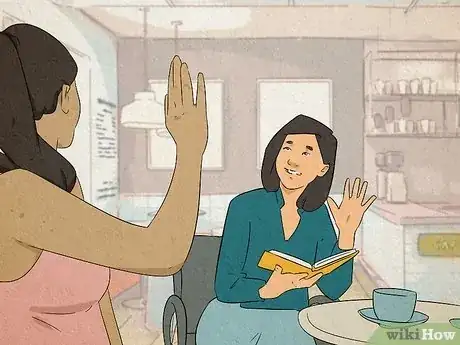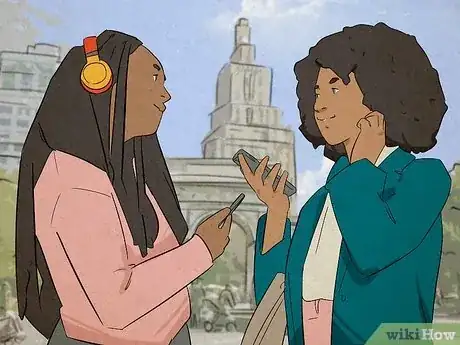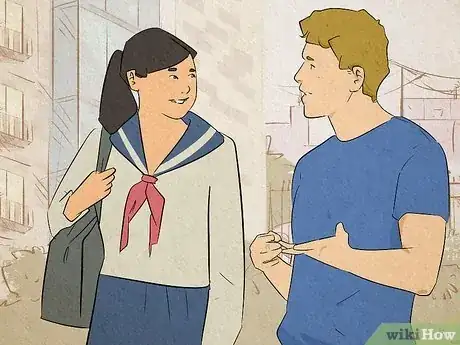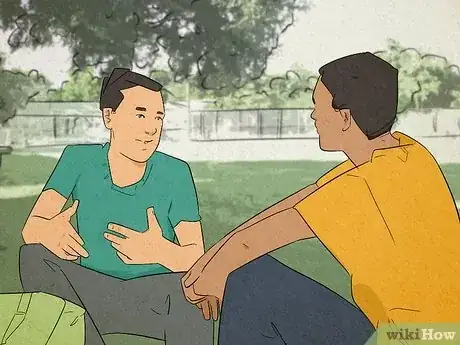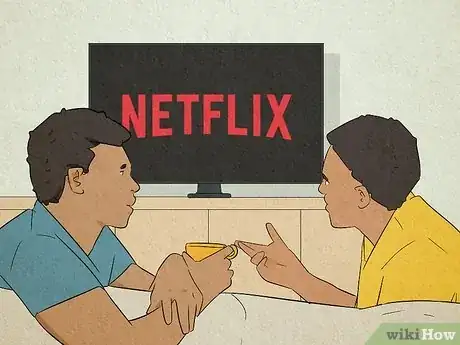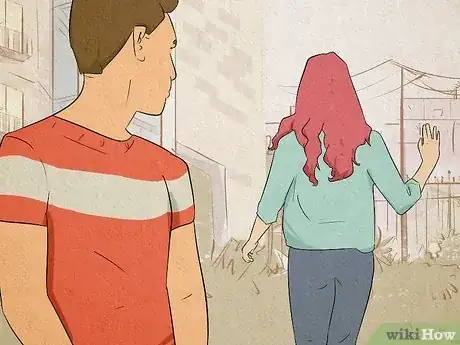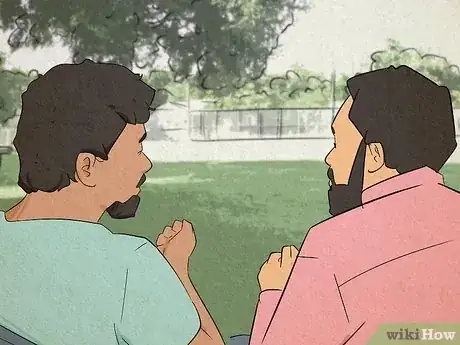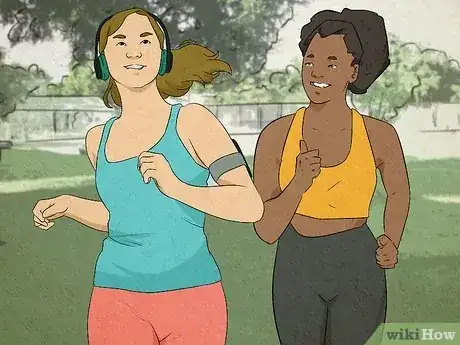This article was co-authored by Lynda Jean. Lynda Jean is an Image Consultant and the Owner of Lynda Jean Image Consulting. With over 15 years of experience, Lynda specializes in color and body/style analysis, wardrobe audits, personal shopping, social and professional etiquette, and personal and business branding. She works with clients to enhance their image, self-esteem, behavior, and communication to facilitate their social and career goals. Lynda holds Bachelor degrees in Sociology and Social Work, a Master’s degree in Clinical Social Work, and a Certified Image Consultant (CIC) certification. She studied Image Consulting at the International Image Institute and the International Academy of Fashion and Technology in Toronto, Canada. Lynda has taught Image Consulting courses at George Brown College in Toronto, Canada. She is the co-author of the book, “Business Success With Ease,” where she shares her knowledge about, ‘The Power of Professional Etiquette.’
There are 8 references cited in this article, which can be found at the bottom of the page.
This article has been viewed 115,706 times.
Friendships are a vitally important aspect of life, but sometimes making friends can seem tough. Perhaps there is a new person in your school or at your job who seems cool or fun, and you’d like to get to know them. You can develop a friendship with this person through breaking the ice, having meaningful conversations, and spending time together.
Steps
Breaking the Ice
-
1Smile. When you see them, greet them with a kind smile.[1] Smiles indicate friendliness and warmth. You may have never smiled at or even made eye contact with them before, so they may have no idea that you want to be friends with them. Smiling will plant a seed in their mind that you have some level of interest. They won’t be as caught off guard when you actually do speak to them.
- Facial expressions can be contagious. People tend to unconsciously imitate the facial expressions of people they are interacting with. If you smile, there is a good chance the other person will smile back.
- The act of smiling can also affect your mood and help you feel happier. A mutual smile can help boost both of your moods and get things off on the right foot.[2]
-
2Greet them with a “hello.” If you see them in the mornings or walk past them on your way to class, greet them with “hello.” This will likely begin to spark an interest in them to know more about you and to talk to you. This also will guarantee that they notice you.[3]Advertisement
-
3Introduce yourself. This is the most basic first step in actually making friends with someone whom you have not yet met. There is a chance that they know who you are or have been wanting to talk to you as well, so think about that in case you get nervous. Take a moment to approach them when you have some downtime and introduce yourself by name.[4]
- You might say “Hi, my name is Henry Locklear. I’m a junior. What’s your name?”
- You might want to shake their hand, especially if you are in a professional setting.
-
4Ask your mutual friends to introduce you. If you have mutual friends with this person, a great and non-threatening way to make their acquaintance is to have your friends introduce you to them. This is perhaps the easiest and most effective way to break the ice. If the two of you have mutual friends, it is all the more likely that you will hit it off as well.
-
5Ask a favor. One way to begin having small conversations with them is to ask for a small favor. This is another way to guarantee that you are noticed and a way to start building rapport with them. For instance, you might ask them something like, “Can you grab a pencil for me?” if they are standing by the supplies desk in the classroom.[5]
- You might also ask something like, “Can you let me borrow a piece of paper?” if you have a class with them.
-
6Ask a question. Another great way to begin having small conversations is to ask small, simple questions. They will appreciate the opportunity to be able to help you if you ask questions like “What chapter did the teacher say we should turn to?” or “What is our homework assignment for next week?”[6]
- If you’re lucky, they may begin to rely on you when they have questions as well, and then you can spark up more conversations.
- Always listen more than you speak. Try to show your interest in the other person to really break the ice and keep the conversation going.[7]
-
7Make a small statement. You can also begin the conversation with them by making small statements that don’t necessarily require a response. Saying things like “Wow, it’s a gorgeous day today,” or “This breakfast is so good!” are great ways to speak to them without fear, because these types of statements do not require a response. However, they will likely respond to you if interested in chatting, so continue the conversation from there.[8]
-
8Compliment them. Remember that people respond well to being praised. Compliment the person on their hair, their projects, or anything else about them that you like or admire. Do not resort to flattery, however, because this will make you seem fake and like you are perhaps interested in more than just friendship.
- Don’t compliment them too often, however. Once to twice per week is a good amount.
-
9Recognize the power of laughter. Laughter always helps to loosen people up. Share a funny joke or a witty comment with them. Laughter can create a powerful and lasting impression – people remember other people and situations that made them laugh. Don't be discouraged if the person doesn't find it funny; it's not the end of the world.[9]
-
10Practice open body language. Remember that communication is twofold: verbal and nonverbal. Even when you are not speaking, you are still communicating with others. Practice open body language by keeping your legs and arms uncrossed. Avoid frowning and looking down when they speak, as well.[10]
- Another technique to help make friends is “mirroring”. This involves mimicking whatever posture or expression that the person you’re speaking to is doing. For instance, if they are leaning their head slightly left, you could do the same while talking to them.
-
11Stay calm. Try not to overthink the situation. Just pay attention to what is happening in the moment, rather than trying to analyze every detail of the interaction. Though you want to make friends with this person, remember that they may be just as nervous as you are. Remember that your new potential friend may be shy or not accustomed to being approached by new people. If you approach them calmly, they are more likely to be calm, as well.[11] .
- Breathe deeply before you talk to them. Deep breaths help calm you down.
Deepening the Conversation
-
1Ask for their number. If you want to continue the conversation beyond asking basic favors or questions, you will need to ask them for their number so that you can communicate with them more. If they don’t have a cell phone, ask them if they have social media so you can connect with them there. You can also ask if they prefer to call or to text.
- You might say something like “You seem so fun! Can I have your number so I can text you?”
-
2Start off with only slightly personal questions. As you begin developing your friendship, you will want to start things off slowly so that you don’t overwhelm the other person and so you avoid oversharing. Though a necessary part of friendship building is getting to know each other, remember that you have time to do so, so you should not rush it. Start off by asking them only slightly personal questions.[12]
- For instance, you might ask where they live, if they have siblings, their favorite movie, favorite book, etc. Also, if you two have a mutual friend, try asking how they met or what brought them to the group, for example.[13]
-
3Begin to ask progressively deeper questions. As your relationship continues to grow and develop, you can increasingly begin to ask the deeper questions which will help you grow an even closer friendship with one another. Think about the things that you want to know about them and begin asking them these questions.[14]
- For instance, you might ask something like “What’s your favorite childhood memory?” or “What’s your relationship like with your mom?”
-
4Share information about yourself. In asking your new friend to share things about themselves, don’t forget that you should be opening up as well. When they ask you a question, you should answer it as long as you feel comfortable and you trust them with the information. Never ask them a question that you yourself would not feel okay answering.
- Also, you can answer your own questions. For instance, if you have asked them something like “What do you want to do when you grow up?”, you can also answer that question for them after they have had time to answer you.
-
5Figure out what their interests are. Take some time to find out what kinds of things they are interested in and share your own interests as well. If your interests should align in some areas, that’s great! But if they don’t, that’s okay, too. You can take the time to learn about each other’s interests.[15]
- Find out what kind of food, movies, books, and hobbies they like.
- Learning about someone else’s interests, even if they are different from your own, is a great way to help foster a friendship and expand your own horizons. Let them teach you something about their interests and hobbies.
-
6Know when to walk away. Not everyone is meant to be your friend. There are certain qualities and characteristics that need to exist between two people in order for a true and persistent friendship to form. If this new person seems resistant or reluctant to speak to you, only responds to your texts occasionally, and never wants to hang out, then you should just cut your losses and accept that this person is not a good fit to be your friend. The good news, however, is that there are plenty of other awesome people for you to connect with!
- Remember that if someone wants to talk to you, you won’t have to initiate contact all of the time and they won’t ignore your texts or phone calls. They will be happy to see you and excited about this new friendship.
Developing your Friendship
-
1Continue conversations. After your initial conversations, continue talking to your friend regularly. Call and text them at least weekly. The amount of contact you have will depend upon your ages as well as the frequency with which you communicate. For instance, if you are in high school, it is normal to talk to your best friends every day. However, if you are older and working, you may speak less regularly as you will have other responsibilities to manage.
- Make sure not to be the only one initiating contact. If you find that nine times out of ten, you’re the one reaching out first, give your friend some space to breathe. If they reach out first, it will make your friendship stronger and more mutual.
-
2Invite them to hang out. Spend some time with your new friend doing fun things either alone or as a part of a group. Go hang out at the mall or see a movie together, or get active and perhaps play a game of soccer or softball at the park.[16]
- Group outings are fun, but remember that you will be able to deepen your relationship more if it’s just the two of you hanging out.
-
3Try something new together. In addition to doing things with them that you both enjoy doing, you can also try new things! Trying something new is a good way to get both of you out of your comfort zone and even perhaps to face your fears together. It’s also a great way to bond because the two of you will be out of your comfort zone and may have to rely on one another for support.
- Bond over cooking a new dish together or trying out a new sport.
- You can also conquer a mutual fear like a fear of heights together by riding a rollercoaster or something similar.
-
4Enjoy your new friendship. After you have spent time in conversation and spent time hanging out with one another, continue to develop your new friendship and work on strengthening it. Continue to spend time together and to talk regularly. But most importantly, have fun! Friendships are meant to be fun!
Community Q&A
-
QuestionWhat should I do if the person does not like making new friends?
 Community AnswerIf they don't seem to to want to make any friends, then don't rush it. The more you pressure a reluctant person into being your friend, the further you will push them away. Give the person lots of time, or find someone who does want to make friends.
Community AnswerIf they don't seem to to want to make any friends, then don't rush it. The more you pressure a reluctant person into being your friend, the further you will push them away. Give the person lots of time, or find someone who does want to make friends. -
QuestionI can approach most people to say hello, but I find it so hard to just walk up and speak to this one person. They are a sporty/popular person and I'm not.
 Community AnswerAnd that is what makes you different. When approaching this kid, just BE YOU. I know it is definitely easier said than done, but honestly it's the best way. Breathe deeply. Remain calm and bring up a neutral conversation topic like school, teachers, etc., or ask the kid about sports (learn something new). Do not fear having different interests because at the end of the day, that's often what people will like about you.
Community AnswerAnd that is what makes you different. When approaching this kid, just BE YOU. I know it is definitely easier said than done, but honestly it's the best way. Breathe deeply. Remain calm and bring up a neutral conversation topic like school, teachers, etc., or ask the kid about sports (learn something new). Do not fear having different interests because at the end of the day, that's often what people will like about you. -
QuestionHow do I approach this person when she is in her friend group at recess, and I don't know anyone else in the group? Kids don't take well to that at my school.
 Community AnswerYou could use a question about a class assignment as a pretext for talking to that person, even if she's with her friends at the time you approach her.
Community AnswerYou could use a question about a class assignment as a pretext for talking to that person, even if she's with her friends at the time you approach her.
References
- ↑ Lynda Jean. Certified Image Consultant. Expert Interview. 17 November 2020.
- ↑ https://www.psychologytoday.com/blog/prefrontal-nudity/201208/smile-powerful-tool
- ↑ http://www.primermagazine.com/2016/live/dont-know-anyone-at-the-party-5-simple-steps-to-make-friends-and-be-magnetic-at-andy-social-event
- ↑ http://www.primermagazine.com/2016/live/dont-know-anyone-at-the-party-5-simple-steps-to-make-friends-and-be-magnetic-at-andy-social-event
- ↑ https://www.psychologytoday.com/blog/the-attraction-doctor/201112/break-the-ice-how-talk-girls-and-guys-0
- ↑ https://www.psychologytoday.com/blog/the-attraction-doctor/201112/break-the-ice-how-talk-girls-and-guys-0
- ↑ Lynda Jean. Certified Image Consultant. Expert Interview. 17 November 2020.
- ↑ https://www.psychologytoday.com/blog/the-attraction-doctor/201112/break-the-ice-how-talk-girls-and-guys-0
- ↑ http://tinybuddha.com/blog/11-ways-to-turn-strangers-into-friends/
- ↑ http://www.primermagazine.com/2016/live/dont-know-anyone-at-the-party-5-simple-steps-to-make-friends-and-be-magnetic-at-andy-social-event
- ↑ http://www.telegraph.co.uk/sponsored/lifestyle/how-to-improve-confidence/11243938/how-to-talk-to-women.html
- ↑ http://socialpronow.com/blog/worlds-fastest-way-to-become-friends/
- ↑ Lynda Jean. Certified Image Consultant. Expert Interview. 17 November 2020.
- ↑ http://socialpronow.com/blog/worlds-fastest-way-to-become-friends/
- ↑ http://tinybuddha.com/blog/11-ways-to-turn-strangers-into-friends/
- ↑ http://www.succeedsocially.com/sociallife
- ↑ Lynda Jean. Certified Image Consultant. Expert Interview. 17 November 2020.


